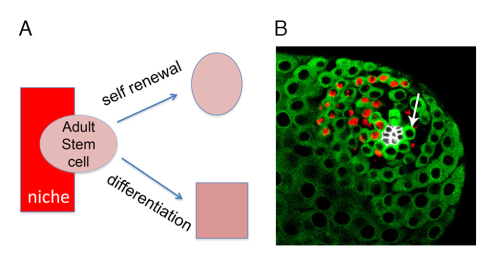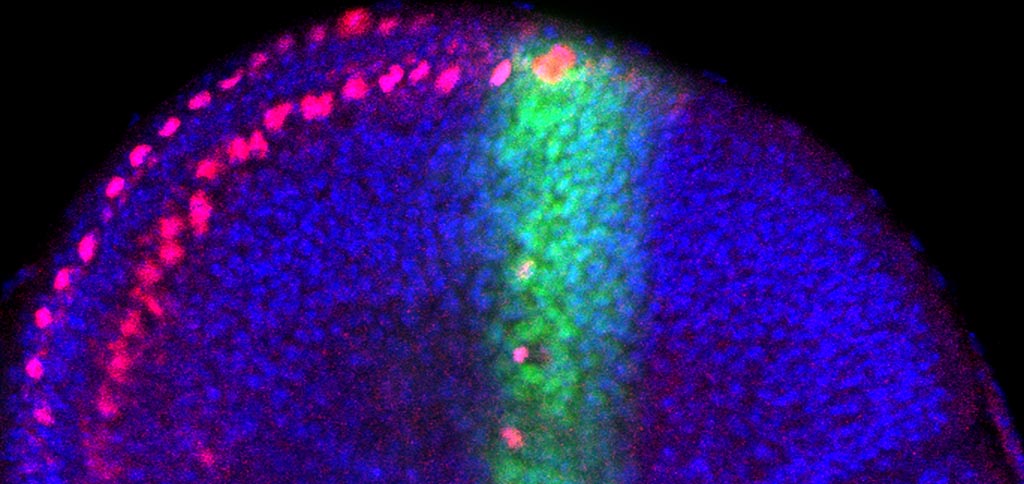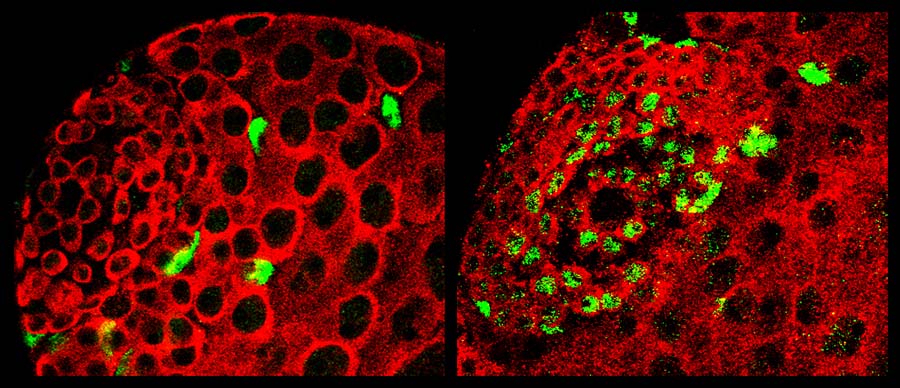恭賀!本實驗室張翊倢博士後研究員
發表有關於性腺幹細胞恆定的研究,已被 PLOS Genetics 雜誌接受
- 皮海薇 副教授
- 03-211-3300 #3361
Pi Laboratory Introduction
We use the Drosophila melanogaster, the fruit fly, as our model system. There are two major topics in the lab: (1) the specification and formation of sensory organ precursors (SOPs). The Drosophila external sensory (ES) organs, or called bristles, are the major mechanosensory organs on the body surface for sensing the mechanical stimulation such as wind or touch (. Each ES organ, composed of four distinct cells, is developed from a single precursor, the SOP, which is selected from neural epithelium by the action of the highly conserved proneural proteins. Our research focus is how the proneural proteins promote the SOP specification and formation. We are currently investigating the role of nuclear actin and actin-related protein in the functions of proneural proteins. The structure and the developmental process of ES organ is similar to that of the vertebrate inner ear hairs. Knowledge of the ES organ development will help us to find the mechanism in repairing and regenerating the inner ear hairs.
(2) Adult stem cells are vital to maintain tissue homeostasis and organ function. After cell division, adult stem cells renew themselves and also generate daughter cells undergoing differentiation. The balance between self-renew and differentiation is key to the normal functions of adult stem cells. We choose the cyst stem cells in the Drosophila testis as our model system to study the function and regulation of adult stem cells. Cyst stem cells produce cyst cells, essential for germ cell differentiation. Loss of cyst stem cells blocks germ cell differentiation and leads to male sterility. Our study identifies a novel signaling pathway for regulation of cyst stem cell self-renew. Hyperactivation of this signaling pathway leads to accumulation of cyst stem cells, and lack of differentiated cyst cells and germ cells. We are currently investigating how this pathway controls self-renewal and how its activity is regulated in the male gonad.
Fig. 1. Drosophila external sensory organs. (A) Adult Drosophila. (B) The external sensory organs, or called bristles, located on the body surface. A single external sensory organ is shown in a red box. (C) Each external sensory organ is composed of four cells: hair cells, socket cells, neuron and sheath cells. (D) The bHLH proneural proteins are essential for the specification and formation of the precursor, which then develop into a single external sensory organ.
Fig. 2. Adult stem cells in the Drosophila male germline. (A) The adult stem cells reside near the niche to receive the self-renewal signal. After each division, one daughter cell remains as the stem cell (self-renewal), the other daughter cell differentiates. (B) The apex of male adult testis. The niche, composed of 10-20 somatic cells, is located at the tip (white). The cells immediately surround the niche are the stem cells (indicated by arrow).
我們主要是用果蠅這個研究基因功能的最佳模式生物來探討這個問題,並搭配細胞生物學,分子生物學,遺傳學,及共軛焦顯微鏡等實驗技術。我們主要有二個研究方向:(1)果蠅外感覺器官母細胞的形成。果蠅外感覺器官,又稱剛毛,遍佈在果蠅體表來感受外界的機械性刺激(例如觸摸或空氣流動) (Fig. 1A and 1B)。每根剛毛是由一個感覺器官母細胞所發育過來 (Fig. 1D)。我們目前主要在探討母細胞形成的過程中,原神經蛋白 (proneural protein) 的核內作用。原神經蛋白為形成剛毛的主宰基因,主要功能為活化母細胞形成及分化作用。我們目前在研究核內肌動蛋白及相關蛋白對原神經蛋白的影響。果蠅剛毛的構造及功能和脊椎動物內耳聽覺小毛相似。我們希望藉由研究果蠅剛毛的形成及功能,來進一步提供內耳小毛受損時可能的修復機制。
(2)成體幹細胞為維持成體組織衡定及器官功能的重要細胞。其一方面藉著產生進入分化的子細胞來修補受損組織及維持功能,並一方面又不斷的藉著自我更新來維持幹細胞的數目(Fig. 2A)。我們實驗室主要探討這種分化/ 自我更新的平衡是如何被調控。我們的研究對象是雄性生殖腺內的囊幹細胞。囊幹細胞會不斷藉著產生囊細胞來保護及調節配子細胞的形成及分化。當囊幹細胞功能不足的情況下,性腺中的配子細胞會分化不完全而導至雄性果蠅不孕。我們目前的實驗發現囊幹細胞的自我更新的能力受到一個訊息傳導路徑的調控。當這個路徑太強時,囊幹細胞會大量增生但不進行分化,導至性腺產生類似癌化的現象。我們現在的重點在研究在正常的情況下,這個訊息傳遞路徑如何在囊幹細胞分化過程中被抑制,以及這個訊息傳遞路徑如何控制囊幹細胞。
圖一・果蠅外感覺器官
(A) 成蟲果蠅。 (B) 成蟲果蠅外感覺器官,又稱剛毛,位於身體表面。 紅色框框內是一個單一的外感覺器官。(C) 每一個外感覺器官是由四個細胞組成:毛細胞,囊細胞,神經細胞,鞘細胞。(D) 原神經蛋白促進母細胞的形成。母細胞形成後,會繼續進行分裂及分化的過程成為一個外感覺器官。
圖二・果蠅雄性性腺內的成體幹細胞
(A) 成體幹細胞位於微環境中去接受自我更新的訊號。幹細胞每次分裂後,其中一個子細胞會藉由自我更新的機制再成為幹細胞,而另一個子細胞會進行分化作用。(B) 雄性性腺前端。由十到二十個體細胞所組成的微環境(白色)位於性腺的最頂端。而最鄰近微環境的細胞就是幹細胞(箭頭)。
Recent Publications
Reproduction disrupts stem cell homeostasis in testes of aged male Drosophila via an induced microenvironment
Stem cells rely on instructive cues from their environment. Alterations in microenvironments might contribute to tissue dysfunction and disease pathogenesis. Germline stem cells (GSCs) and cyst stem cells (CySC) in [...]
The COP9 signalosome converts temporal hormone signaling to spatial restriction on neural competence.
During development, neural competence is conferred and maintained by integrating spatial and temporal regulations. The Drosophila sensory bristles that detect mechanical and chemical stimulations are arranged in stereotypical positions. [...]
Proneural proteins Achaete and Scute associate with nuclear actin to promote formation of external sensory organs.
Basic helix-loop-helix (bHLH) proneural proteins promote neurogenesis through transcriptional regulation. Although much is known about the tissue-specific regulation of proneural gene expression, how proneural proteins [...]
Smurf-mediated differential proteolysis generates dynamic BMP signaling in germline stem cells during Drosophila testis development
Germline stem cells (GSCs) produce gametes throughout the reproductive life of many animals, and intensive studies have revealed critical roles of BMP signaling [...]








